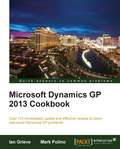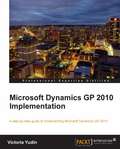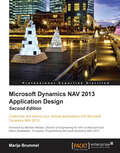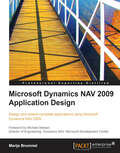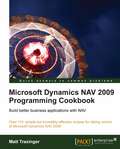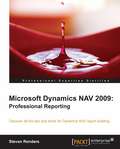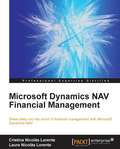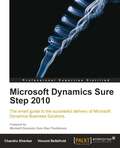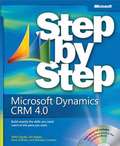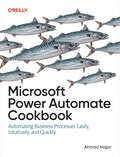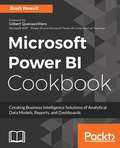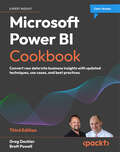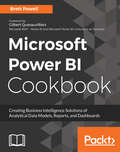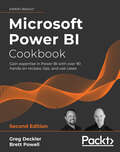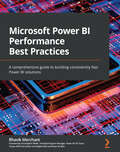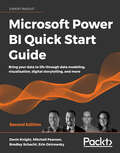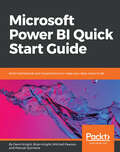- Table View
- List View
Microsoft Dynamics GP 2010 Cookbook
by Mark PolinoAs a cookbook, this book enables you to solve real-world Dynamics GP problems with immediately useable recipes that unleash the powerful functionality of Dynamics GP. The book provides tips, techniques, and solutions designed to show users how to improve their use of Dynamics GP, not simply perform basic tasks. If you are a Dynamics GP user or Dynamics GP partner primarily focused on delivering time-proven application optimizations, then this book is for you. This book assumes that you have a basic understanding of business management systems, with basic knowledge of Microsoft Dynamics GP. All the recipes are real-world tested and designed to be used immediately.
Microsoft Dynamics GP 2013 Cookbook
by Ian Grieve Mark PolinoMicrosoft Dynamics GP 2013 Cookbook is a highly practical beginner to intermediate Cookbook to improve your efficiency and master your use of Microsoft Dynamics GP 2013. All the recipes are time-proven; real-world tested, and designed to be used immediately.If you're a Dynamics GP partner or Dynamics GP user, primarily focused on delivering application optimizations, then "Microsoft Dynamics GP 2013 Cookbook" is for you.This book assumes that you have a basic knowledge of Microsoft Dynamics GP, a basic understanding of business management systems, and some exposure to Microsoft SQL Server.
Microsoft Dynamics GP 2013 Implementation
by Victoria YudinA step-by-step guide for planning and carrying out your Microsoft Dynamics GP 2013 implementation. Detailed descriptions and illustrations of setup screens and practical examples and advice are included for the Dynamics GP system and core modules.If you are a new or existing Microsoft Dynamics GP consultant or an end user who wants to implement, install, and set up core modules of Dynamics GP 2013, then this book is for you. A basic understanding of business management systems and either Dynamics GP or a similar application is recommended.
Microsoft Dynamics NAV 2009 Application Design: Customize and extend your vertical applications with Microsoft Dynamics NAV 2013, 2nd Edition
by Mark BrummelThis book is a tutorial in an easy-to-read style. It will show Dynamics NAV developers how to create applications of different kinds with sufficient examples throughout. If you are a NAV consultant and developer, or designer of business applications you will benefit most from this book. The book assumes that you have a basic understanding of business management systems and application development, with a working knowledge of Microsoft Dynamics NAV.
Microsoft Dynamics NAV 2009 Application Design: Design and extend complete applications using Microsoft Dynamics NAV 2009
by Mark BrummelThis book is a tutorial in an easy-to-read style. It will show Dynamics NAV developers how to create applications of different kinds with sufficient examples throughout. If you are a NAV consultant and developer, or designer of business applications you will benefit most from this book. The book assumes that you have a basic understanding of business management systems and application development, with a working knowledge of Microsoft Dynamics NAV.
Microsoft Dynamics NAV 2009 Programming Cookbook
by Matt TraxingerYou won't find any fluff here. This book is written in a direct, to-the-point style to help you get what you need and continue working in NAV. At the same time it provides enough explanation so that you understand what we are doing and why it is necessary.In many programming books you will find yourself searching through paragraph after paragraph to try to find what you are looking for. That's not the case here. Each recipe starts with a short description of what it will teach. It is immediately followed with directions, usually with illustrations, of how to perform the task. You will find the explanation of the code at the end, along with some advice for further reading or other tasks you might be interested in.If you are a junior / entry-level NAV developer then the first half of the book is designed primarily for you. You may or may not have any experience programming. It focuses on the basics of NAV programming. It would be best if you have gone through a brief introduction to the NAV client.If you are a mid-level NAV developer, you will find the second half more useful. These chapters explain how to think outside of the NAV box when building solutions.There are also recipes here and there that senior developers will find useful.
Microsoft Dynamics NAV 2009: Professional Reporting
by Steven RendersThis book doesn't assume any prior experience with Dynamics NAV reporting. It is designed as an easy to follow guide, where each chapter builds upon the previous one, but can also be read completely separately. Basically this book is for everyone who is using Microsoft Dynamics NAV or has an interest on the reporting capabilities of NAV 2009. The book does not have major prerequisites, although it is mainly focused on Dynamics NAV 2009, RDLC and Business Intelligence. Whether you are a Dynamics NAV consultant, developer, customer, project manager, or just interested in the reporting capabilities of Dynamics NAV, this book can provide you with information from a helicopter view down to the smallest details, tips and tricks, and workarounds. Empowered with the information in this book you should be able to master, analyse and deliver the most challenging reporting requirements in Dynamics NAV.
Microsoft Dynamics NAV 2016 Financial Management - Second Edition
by Anju BalaThis book will appeal to financers and accountants who are using Dynamics NAV as their ERP and financial management system. Dynamics NAV consultants and project managers will also find it useful for their daily work
Microsoft Dynamics NAV Financial Management
by Laura Nicolas Lorente Cristina Nicolas LorenteThis book is an in-depth, practical tutorial demonstrating both the essential basic concepts and the more advanced concepts of financial management in Dynamics NAV.This book is for financers and accountants who are using Dynamics NAV as their ERP and financial management system. It will also help Dynamics NAV consultants and project managers of organizations who use the system for their daily work. Additionally, the book helps Dynamics NAV developers to understand the use of standard applications in organizations and helps them to develop improved features that are better integrated with existing ones.
Microsoft Dynamics Sure Step 2010
by Chandru Shankar Vincent BellefroidA focused tutorial, this book is much more than just another step-by-step guide into project management. This book shows you how to implement Microsoft Dynamics Sure Step business solutions, with Microsoft Dynamics Sure Step providing the basis. This book will also help you to plan, align, and orchestrate your sales activities. It will orient you to tactics required to be efficient, proactive, goal driven and flexible in your Microsoft Dynamics engagements. If you are a Dynamics consultant, developer, or in a customer resources or sales role that requires guidance and knowledge of the ERP/CRM business solutions space or to deliver business solutions that meet or exceed the expectations of your organization, then this book is ideal for you.
Microsoft Dynamics® CRM 4.0 Step by Step
by Mike Snyder Jim Steger Kara O'Brien Brendan LandersWhether you're in sales, marketing, or customer service--quickly teach yourself how to get closer to your customers with Microsoft Dynamics CRM. With STEP BY STEP, you set the pace--building and practicing the skills you need, just when you need them! Create and manage accounts--for a 360º view of your customers and business Work with Microsoft Dynamics CRM directly from Microsoft Outlook Track customer activity; import and map data automatically Manage campaigns, leads, quotes, contracts, and orders Employ basic to advanced reporting capabilities Your all-in-one learning experience includes: Files for building skills and practicing the book's lessons Fully searchable eBook Sample chapters from related Microsoft Press books WINDOWS VISTA PRODUCT GUIDE eReference--plus other resources--on CD A Note Regarding the CD or DVD The print version of this book ships with a CD or DVD. For those customers purchasing one of the digital formats in which this book is available, we are pleased to offer the CD/DVD content as a free download via O'Reilly Media's Digital Distribution services. To download this content, please visit O'Reilly's web site, search for the title of this book to find its catalog page, and click on the link below the cover image (Examples, Companion Content, or Practice Files). Note that while we provide as much of the media content as we are able via free download, we are sometimes limited by licensing restrictions. Please direct any questions or concerns to booktech@oreilly.com.
Microsoft Dynamics® CRM 4.0 Step by Step
by Mike Snyder Jim Stegerxecutives from Sonoma Partners introduce the common modules of Microsoft Dynamics CRM used to understand customers better, increase sales and productivity, and improve customer satisfaction. Step-by-step instructions walk through creating a lead or quote, managing marketing lists and campaigns, tracking service requests, and publishing a knowledge base article. The CD-ROM contains practice files, a Microsoft computer dictionary, and a Vista product guide. Annotation ©2009 Book News, Inc. , Portland, OR (booknews. com)
Microsoft Exchange Server 2013 High Availability
by Nuno MotaThis book is a hands-on practical guide that provides the reader with a number of clear scenarios and examples, making it easier to understand and apply the new concepts. Each chapter can be used as a reference, or it can be read from beginning to end, allowing consultants/administrators to build a solid and highly available Exchange 2013 environment. If you are a messaging professional who wants to learn to design a highly available Exchange 2013 environment, this book is for you. Although not a definite requirement, practical experience with Exchange 2010 is expected, without being a subject matter expert.
Microsoft Office 2000
by Kerry Herman Alan MacCormackDescribes the history of Microsoft's Office product suite. Discusses evolution of the Office 2000 project. Set at the end of the project when Steven Sinofsky, Office vice president, must decide upon the direction for the next version of Office, as well as make changes to the process. This case is also available in multimedia format on a CD-ROM, order # 9-600-023. Must be used in conjunction with video # 9-600-502.
Microsoft Office 2000
by Alan Maccormack Kerry HermanDescribes the history of Microsoft's Office product suite. Discusses evolution of the Office 2000 project. Set at the end of the project when Steven Sinofsky, Office vice president, must decide upon the direction for the next version of Office, as well as make changes to the process. This case is also available in multimedia format on a CD-ROM, order # 9-600-023. Must be used in conjunction with video # 9-600-502.
Microsoft Office 2007
by Marco Iansiti Bianca BuccitelliA discussion of the history and processes behind the development of Microsoft's Office 12 software.
Microsoft Office 2016: In Practice
by Kathleen Stewart Randy Nordell Moraine Valley Annette Easton Pat GravesMicrosoft Office 2016: In Practice offers a fresh approach to teaching today's students Microsoft Office skills by clearly introducing skills in a logical sequence: 1) Topic 2) Instruction and 3) Practice. Nordell's T.I.P.s approach builds a foundation for success by helping students practice what they learn, and provides transferable skills that allow students to grasp critical thinking beyond the textbook assignment. In Practice seamlessly integrates with SIMnet Online, McGraw-Hill Education's learning and assessment solution, which has 1:1 content to help students practice and master computing concepts and Microsoft Office skills.
Microsoft Power Automate Cookbook
by Ahmad NajjarDespite recent advances in technology, software developers, enterprise users, and business technologists still spend much of their time performing repetitive and manual tasks. This cookbook shows you how to level up your automation skills with Power Automate to drive efficiency and productivity within your organization.Author Ahmad Najjar provides recipes to help you complete common tasks and solve a wide range of issues you'll encounter when working with Power Automate. This cookbook guides you through fundamental concepts as well as intermediate-to-advanced Power Automate activities—everything from understanding flow components to automating approvals, building business process flows, and integrating Power Automate with other applications and services. You'll also learn how Microsoft 365 services correlate and integrate with Power Automate.This cookbook shows you how to:Use Power Automate to create a standard workflowIntegrate Power Automate with other applications and servicesLeverage other Power Platform tools with Power AutomateUse Power Automate to work with files and build basic business process flowsSend notifications and reminders using Power AutomateBuild robotic process automation flows using Power Automate DesktopTrigger workflows on demandAdminister and govern Power Automate flows
Microsoft Power BI Cookbook
by Brett Powell<P><P>Key Features <P><P>From connecting to your data sources to developing and deploying immersive, mobile-ready dashboards and visualizations, this book covers it all <P><P>Over 90 hands-on, technical recipes, tips, and use cases from across the Power BI platform including the Power BI Service and Mobile Applications <P><P>Proven development techniques and guidance for implementing custom solutions with DAX and M languages <P><P>Book Description <P><P>Microsoft Power BI is a business intelligence and analytics platform consisting of applications and services designed to provide coherent, visual and interactive insights of data. <P><P>This book will provide thorough, technical examples of using all primary Power BI tools and features as well as demonstrate high impact end-to-end solutions that leverage and integrate these technologies and services. Get familiar with Power BI development tools and services, go deep into the data connectivity and transformation, modeling, visualization and analytical capabilities of Power BI, and see Power BI’s functional programming languages of DAX and M come alive to deliver powerful solutions to address common, challenging scenarios in business intelligence. <P><P>This book will excite and empower you to get more out of Power BI via detailed recipes, advanced design and development tips, and guidance on enhancing existing Power BI projects. <P><P>What you will learn <P><P>Cleanse, stage, and integrate your data sources with Power BI <P><P>Abstract data complexities and provide users with intuitive, self-service BI capabilities <P><P>Build business logic and analysis into your solutions via the DAX programming language and dynamic, dashboard-ready calculations <P><P>Take advantage of the analytics and predictive capabilities of Power BI <P><P>Make your solutions more dynamic and user specific and/or defined including use cases of parameters, functions, and row level security <P><P>Understand the differences and implications of DirectQuery, Live Connections, and Import-Mode Power BI datasets and how to deploy content to the Power BI Service and schedule refreshes <P><P>Integrate other Microsoft data tools such as Excel and SQL Server <P><P>Reporting Services into your Power BI solution
Microsoft Power BI Cookbook: Convert raw data into business insights with updated techniques, use cases, and best practices
by Greg Deckler Brett PowellNow in color, this edition helps you unlock the full potential of Power BI with new recipes and comprehensive techniques on advanced data tools and AIKey FeaturesDive into Microsoft Data Fabric for deeper insights and robust data strategiesImplement Hybrid tables, create comprehensive scorecards, and establish shared cloud connections effortlesslyUncover new and updated data visualization tools that turn complex data into clear, actionable charts and reportsPurchase of the print or Kindle book includes a free eBook in PDF formatBook DescriptionSince its first edition the Power BI Cookbook has been a best-selling resource for BI developers and data analysts to produce impactful, quality BI solutions. This new and updated edition retains the rigorous details and concepts readers of prior editions have enjoyed while also demonstrating powerful new capabilities and updated guidance aligned to the current state of the platform. In this book, with step-by-step instructions, you will learn to navigate the complexities of data integration and visualization in Power BI. From creating robust data models to implementing sophisticated reporting techniques, this Power BI book empowers you to make informed decisions based on actionable insights. It also introduces you to new capabilities such as Hybrid tables and scorecards, enhancing your ability to communicate and analyze business performance. It also expands and improvises on the core of the previous edition like parameterizing Power BI solutions, authoring reports, data intelligence, and integrating advanced analytics. This edition not only updates you on the latest features but also prepares you for future innovations with a preview of upcoming AI enhancements in Power BI. Whether you're refining your skills or aspiring to become an expert, this book is an invaluable resource for leveraging Power BI to its fullest potentialWhat you will learnAnalyze and integrate business data using Microsoft Data FabricCreate impactful visualizations and manage Hybrid tablesDevelop shared cloud connections and advanced scorecardsEnhance report accuracy and dynamics using real-time data processingImplement efficient data governance and security measures within Power BIWho this book is forThis book is designed for data analysts, business intelligence professionals, and anyone involved in data processing or analytics who seeks to enhance their skills with Power BI’s latest features and prepare for future advancements in the field
Microsoft Power BI Cookbook: Creating Business Intelligence Solutions Of Analytical Data Models, Reports, And Dashboards
by Brett PowellGet more out of Microsoft Power BI turning your data into actionable insights About This Book • From connecting to your data sources to developing and deploying immersive, mobile-ready dashboards and visualizations, this book covers it all • Over 90 hands-on, technical recipes, tips, and use cases from across the Power BI platform including the Power BI Service and Mobile Applications • Proven development techniques and guidance for implementing custom solutions with DAX and M languages Who This Book Is For This book is for BI professionals who wish to enhance their knowledge of Power BI beyond and to enhance the value of the Power BI solutions they deliver to business users. Those who are looking at quick solutions to common problems while using Power BI will also find this book to be a very useful resource .Some experience with Power BI will be useful. What You Will Learn • Cleanse, stage, and integrate your data sources with Power BI • Abstract data complexities and provide users with intuitive, self-service BI capabilities • Build business logic and analysis into your solutions via the DAX programming language and dynamic, dashboard-ready calculations • Take advantage of the analytics and predictive capabilities of Power BI • Make your solutions more dynamic and user specific and/or defined including use cases of parameters, functions, and row level security • Understand the differences and implications of DirectQuery, Live Connections, and Import-Mode Power BI datasets and how to deploy content to the Power BI Service and schedule refreshes • Integrate other Microsoft data tools such as Excel and SQL Server Reporting Services into your Power BI solution In Detail Microsoft Power BI is a business intelligence and analytics platform consisting of applications and services designed to provide coherent, visual and interactive insights of data. This book will provide thorough, technical examples of using all primary Power BI tools and features as well as demonstrate high impact end-to-end solutions that leverage and integrate these technologies and services. Get familiar with Power BI development tools and services, go deep into the data connectivity and transformation, modeling, visualization and analytical capabilities of Power BI, and see Power BI's functional programming languages of DAX and M come alive to deliver powerful solutions to address common, challenging scenarios in business intelligence. This book will excite and empower you to get more out of Power BI via detailed recipes, advanced design and development tips, and guidance on enhancing existing Power BI projects. Style and approach This book consists of practical recipes on Power BI that target novices as well as intermediate Power BI users. It goes deep into the technical issues, covers additional protocols, and many more real-live examples.
Microsoft Power BI Cookbook: Gain expertise in Power BI with over 90 hands-on recipes, tips, and use cases, 2nd Edition
by Brett Powell Greg DecklerBuild effective analytical data models, reports, and dashboards using the advanced features of Power BI.Purchase of the print or Kindle book includes a free eBook in the PDF format.Key FeaturesUpdate your knowledge with new recipes for query optimization, aggregation tables, Power BI API, and paginated reportsWork with recipes across diverse Power BI platforms including the Power BI Service and Mobile ApplicationsImplement custom solutions with M and DAX languages through actionable guidance and proven development techniquesBook DescriptionThe complete everyday reference guide to Power BI, written by an internationally recognized Power BI expert duo, is back with a new and updated edition. Packed with revised practical recipes, Microsoft Power BI Cookbook, Second Edition, helps you navigate Power BI tools and advanced features. It also demonstrates the use of end-to-end solutions that integrate those features to get the most out of Power BI. With the help of the recipes in this book, you'll gain advanced design and development insight, practical tips, and guidance on enhancing existing Power BI projects. The updated recipes will equip you with everything you need to know to implement evergreen frameworks that will stay relevant as Power BI updates. You'll familiarize yourself with Power BI development tools and services by going deep into the data connectivity, transformation, modeling, visualization, and analytical capabilities of Power BI. By the end of this book, you'll make the most of Power BI's functional programming languages of DAX and M and deliver powerful solutions to common business intelligence challenges.What you will learnCleanse, stage, and integrate your data sources with Power Query (M)Remove data complexities and provide users with intuitive, self-service BI capabilitiesBuild business logic and analysis into your solutions via the DAX programming language and dashboard-ready calculationsImplement aggregation tables to accelerate query performance over large data sourcesCreate and integrate paginated reportsUnderstand the differences and implications of DirectQuery, live connections, Import, and Composite model datasetsIntegrate other Microsoft data tools into your Power BI solutionWho this book is forIf you're a BI professional who wants to up their knowledge of Power BI and offer more value to their organization, then this book is for you. Those looking for quick solutions to common Power BI problems will also find this book an extremely useful resource. Please be aware that this is not a beginner's guide; you'll need a solid understanding of Power BI and experience working with datasets before you dive in.
Microsoft Power BI Performance Best Practices: A comprehensive guide to building consistently fast Power BI solutions
by Christopher Webb Bhavik MerchantSupercharge performance analytics and create repeatable patterns to ensure you get the best performance and scalability from your analytics solutions with Power BIKey FeaturesLearn how to build performant data models and apply Row-Level SecurityIdentify and fix performance issues in reports, DAX, and datasets using DAX Studio/VertiPaq AnalyzerUse a formal process to manage performance, from setting targets to monitoring and remediating issuesBook DescriptionThis book comprehensively covers every layer of Power BI, from the report canvas to data modeling, transformations, storage, and architecture.Developers and architects working with any area of Power BI will be able to put their knowledge to work with this practical guide to design and implement at every stage of the analytics solution development process. This book is not only a unique collection of best practices and tips, but also provides you with a hands-on approach to identifying and fixing common performance issues.Complete with explanations of essential concepts and practical examples, you'll learn about common design choices that affect performance and consume more resources and how to avoid these problems. You'll grasp the general architectural issues and settings that broadly affect most solutions. As you progress, you'll walk through each layer of a typical Power BI solution, learning how to ensure your designs can handle scale while not sacrificing usability. You'll focus on the data layer and then work your way up to report design. We will also cover Power BI Premium and load testing.By the end of this Power BI book, you'll be able to confidently maintain well-performing Power BI solutions with reduced effort and know how to use freely available tools and a systematic process to monitor and diagnose performance problems.What you will learnUnderstand how to set realistic performance targets and address performance proactivelyUnderstand how architectural options and configuration affect performanceBuild efficient Power BI reports and data transformationsExplore best practices for data modeling, DAX, and large datasetsUnderstand the inner workings of Power BI PremiumExplore options for extreme scale with Azure servicesUnderstand how to use tools that help identify and fix performance issuesWho this book is forData analysts, BI developers, and data professionals who have learnt the basics of Power BI and now want to understand how to build advanced analytics solutions will find this business intelligence book useful. Familiarity with the major components of Power BI and a beginner-level understanding of their purpose and use cases are required.
Microsoft Power BI Quick Start Guide: Bring your data to life through data modeling, visualization, digital storytelling, and more, 2nd Edition
by Devin Knight Mitchell Pearson Bradley Schacht Erin OstrowskyAn accessible fast paced introduction to all aspects of Power BI for new or aspiring BI professionals, data analysts, and data visualizersKey FeaturesUpdated with the latest features in Power BI including Dataflow, AI insights, visuals and row level securityGet faster and more intuitive data insights using Microsoft Power BI and its business intelligence capabilitiesBuild accurate analytical models, reports, and dashboardsBook DescriptionThis revised edition has been fully updated to reflect the latest enhancements to Power BI. It includes a new chapter dedicated to dataflow, and covers all the essential concepts such as installation, designing effective data models, as well as building basic dashboards and visualizations to help you and your organization make better business decisions.You'll learn how to obtain data from a variety of sources and clean it using Power BI Query Editor. You'll then find out how you can design your data model to navigate and explore relationships within it and build DAX formulas to make your data easier to work with. Visualizing your data is a key element in this book, and you'll get to grips rapidly with data visualization styles and enhanced digital storytelling techniques.In addition, you will acquire the skills to build your own dataflows, understand the Common Data Model, and automate data flow refreshes to eradicate data cleansing inefficiency.This guide will help you understand how to administer your organization's Power BI environment so that deployment can be made seamless, data refreshes can run properly, and security can be fully implemented.By the end of this Power BI book, you'll have a better understanding of how to get the most out of Power BI to perform effective business intelligence.What you will learnConnect to data sources using import and DirectQuery optionsUse Query Editor for data transformation and data cleansing processes, including writing M and R scripts and dataflows to do the same in the cloudDesign optimized data models by designing relationships and DAX calculationsDesign effective reports with built-in and custom visualsAdopt Power BI Desktop and Service to implement row-level securityAdminister a Power BI cloud tenant for your organizationUse built-in AI capabilities to enhance Power BI data transformation techniquesDeploy your Power BI desktop files into the Power BI Report ServerWho this book is forAspiring business intelligence professionals who want to learn Power BI will find this book useful. If you have a basic understanding of BI concepts and want to learn how to apply them using Microsoft Power BI, this book is for you.
Microsoft Power BI Quick Start Guide: Build dashboards and visualizations to make your data come to life
by Devin Knight Brian Knight Mitchell Pearson Manuel QuintanaBring your data to life with Power BI Key Features Get to grips with the fundamentals of Microsoft Power BI and its Business Intelligence capabilities Build accurate analytical models, reports and dashboards Get faster and more intuitive insights from your data using Microsoft Power BI Book Description Microsoft Power BI is a cloud-based service that helps you easily visualize and share insights using your organization's data.This book will get you started with business intelligence using the Power BI toolset, covering essential concepts such as installation,designing effective data models, as well as building basic dashboards and visualizations to make your data come to life You will learn how to get your data the way you want – connecting to data sources sources and how to clean your data with the Power BI Query Editor. You will next learn how to properly design your data model to make your data easier to work with.. You will next learn how to properly design your data model to navigate table relationships and build DAX formulas to make your data easier to work with. Visualizing your data is another key element of this book, and you will learn how to follow proper data visualization styles and enhanced digital storytelling techniques. By the end of this book, you will understand how to administer your organization's Power BI environment so deployment can be made seamless, data refreshes can run properly, and security can be fully implemented What you will learn Connect to data sources using both import and DirectQuery options Use the Query Editor to apply data transformations and data cleansing processes, including learning how to write M and R scripts Design optimized data models by designing relationships and DAX calculations Leverage built-in and custom visuals to design effective reports Use the Power BI Desktop and Power BI Service to implement Row Level Security on your model Administer a Power BI cloud tenant for your organization Deploy your Power BI Desktop files into the Power BI Report Server Who this book is for This book is for aspiring Business Intelligence professionals who want to get up and running with Microsoft Power BI. If you have a basic understanding of BI concepts and want to learn how to apply them using Microsoft Power BI, this book is for you.

